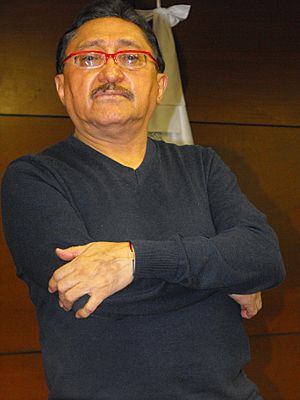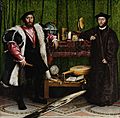Sergio González Rodríguez facts for kids
Quick facts for kids
Sergio González Rodríguez
|
|
|---|---|

Sergio González Rodríguez at Tec de Monterrey, Mexico City
|
|
| Born | 26 January 1950 Mexico City |
| Died | 3 April 2017 (aged 67) Mexico City |
| Occupation | Journalist, critic, essayist and screenwriter |
| Language | Spanish |
| Nationality | Mexican |
| Alma mater | National Autonomous University of Mexico |
| Years active | 1993–2017 |
| Notable works | Bones in the Desert, The Headless Man, The Femicide Machine, The Iguala 43, Field of Battle |
| Notable awards | Fernando Benítez National Journalism Prize (1995) |
Sergio González Rodríguez (born January 26, 1950 – died April 3, 2017) was a Mexican journalist and writer. He was well-known for his important work on the murders of women in Ciudad Juárez during the 1990s and 2000s. Some of his famous books on this topic include Huesos en el desierto (which means Bones in the Desert) and The Femicide Machine.
González Rodríguez was a versatile writer. He wrote in many different styles, including literary journalism (called crónicas in Spanish), novels, essays, and scripts for documentaries. His writing was highly praised and he received several awards in Mexico and Spain.
Contents
Life and Early Years
Sergio González Rodríguez was born in Mexico City in 1950. When he was young, his mother passed away. His father later started a new family.
He studied modern literature at the National Autonomous University of Mexico from 1978 to 1982. Besides being a writer, he was also a rock musician. He played bass guitar with his brothers in a band called Enigma.
After his book Huesos en el desierto was published, González Rodríguez faced a dangerous attack. He was kidnapped and beaten, and warned to stop his work. Even though he was badly hurt, he bravely continued his important journalistic investigations. He passed away in a hospital on April 3, 2017, due to a heart attack.
A Career in Words
González Rodríguez built his career as a critic, storyteller, essay writer, and scriptwriter. After finishing his studies, he worked at the Historical Studies Department of the Instituto Nacional de Antropología e Historia from 1985 to 1988. He also helped coordinate exhibitions for CONACULTA, a cultural organization.
He was involved in journalism for many years. He worked as an editor for Biblioteca de México magazine and Luna Córnea magazine. In 1993, when the Reforma newspaper started, he became an editor and wrote columns for the paper and its cultural section. He also wrote for La Jornada.
González Rodríguez became famous for his deep investigations into the murders of women in Ciudad Juárez. He started reporting on this issue in 1995 for Reforma. His articles became the foundation for his book Huesos en el desierto, published in 2002. This book combined reporting, essays, and his own thoughts. It was recognized internationally and translated into Italian and French. His work even influenced other writers, like Roberto Bolaño, who was writing his novel 2666 at the time.
As a scriptwriter, he wrote for the TV series México, Siglo XX. He also directed a documentary called Nacional Dominical. In 1993, his script for the documentary Los bajos fondos won a top prize at a national festival. He also taught as a professor at the Doctor José María Luis Mora Research Center.
His Important Books
González Rodríguez wrote or helped write over twenty books. He also contributed to many important magazines and journals.
His novels include El triángulo imperfecto (2003), El plan Schreber (2004), La pandilla cósmica (2005), and El vuelo (2008). In 2014, he published El artista adolescente que confundía el mundo con un cómic. This novel creatively used elements from graphic novels and comics in its style and story.
Some of his essays include Los bajos fondos, el antro, la bohemia y el café (1988), El Centauro en el paisaje (1992), De sangre y de sol (2006), and El hombre sin cabeza.
Crónicas: Blending Facts and Thoughts
González Rodríguez wrote three important non-fiction books that explored crime and challenges in Mexico. These books are The Femicide Machine, The Iguala 43 (Los 43 de Iguala), and Field of Battle (Campo de guerra). These books were translated into English and became part of the Semiotext(e) Intervention Series. The Femicide Machine specifically looked at the murders of women in Ciudad Juárez, similar to his earlier book Huesos en el desierto.
These three works are examples of crónicas. A crónica is a Spanish word for a type of literary journalism. It mixes straight facts and reporting with the writer's own thoughts and opinions.
Field of Battle: Understanding Challenges
In Field of Battle, González Rodríguez looked at how Mexican society was becoming more focused on military solutions to violence. The main idea of the book is that when there isn't a strong system of rule of law (meaning laws are not always followed or enforced), it leads to ongoing violence and suffering.
He explained that corruption can weaken the rule of law. This creates a confusing world where it's hard to tell what's legal and illegal. Crimes often go unpunished, and sometimes even law enforcement doesn't follow the rules.
To describe the confusing reality for victims of violence, González Rodríguez used the idea of anamorphosis. This is a visual trick where an image looks distorted unless you view it from a special angle. He used it to show how victims might see their world in a twisted way, caught between corruption and violence.
He believed that people's lives could be seen only for their use in criminal activities, or as "collateral damage" in conflicts. He wrote that the world for those affected by crime can feel empty, filled with rules and whims of criminals.
González Rodríguez ended his book by suggesting nonviolence and respect for the rule of law. He saw these as peaceful ways to fight violence and the increasing focus on military solutions in Mexico.
Awards and Recognition
González Rodríguez received many awards for his writing:
- In 1993, he was a finalist for the Anagrama Essay Prize in Spain for El centauro en el paisaje.
- In 1995, he won the Fernando Benítez National Journalism Prize in Mexico for Mujer de table-dance.
- His book Huesos en el desierto was a finalist for the Lettre Ulysses International Prize in Germany. It also received the Herralde Novel Prize in 2004.
- El triángulo imperfecto (2003) was a finalist for the Antonin Artaud Prize for novels in Mexico.
- In 2013, he won the Premio Casa América Catalunya a la Libertad de Expresión en Iberoamérica.
- In 2014, he won the Anagrama Essay Prize for Campo de guerra.
His work was also supported by grants from important organizations like FONCA and the Rockefeller Foundation. Since 1996, he was a member of the Sistema Nacional de Creadores de Arte of Mexico, which supports artists.
Images for kids
-
González Rodríguez used the idea of anamorphosis to describe the confusing reality for victims of violence. He mentioned the distorted skull in Hans Holbein the Younger's painting The Ambassadors.
See also
 In Spanish: Sergio González Rodríguez para niños
In Spanish: Sergio González Rodríguez para niños


